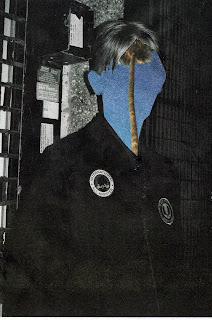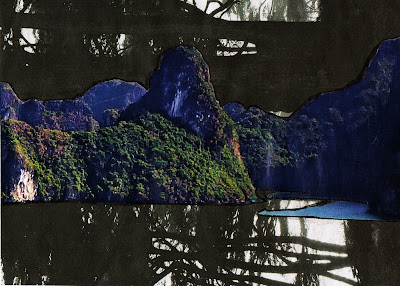Questions were posed to think about how celebrating 'local' and a sense of community and can enhance mental health. To think about the function of a social and cultural space; to make something familiar, unfamiliar.
Being aware through being.
What is the connection between art and health?
It could be argued that all art and culture contributes positively to our health - enabling individual and collective elf experession - provoking dialogue about the world we inhabit and enriching connections, to both ourselves and others.
How can art subtlety bring communities together to enhance relationships and emotional states?
Jeremy Deller's work is all about the happening and the being there.
He explores compelling social and cultural territories while alternately taking on the roles of artistic producer, publisher, filmmaker, collaborator, curator, parade organizer and cultural archivist. Deller devises what might be called social interventions. He has been called "a pied piper of popular culture".

Joy in People, 2012
MINDFULNESS. AWARENESS.
Miranda July focuses her work around closeness, intimacy and interaction with strangers. "The point of art is to transform yourself through understanding".

Eleven Heavy Things
53rd International Art Exhibition at the Venice Biennale, 2009
Center Lawn of Union Square Park in New York from May 29 to October 03, 2010
Pacific Design Center in Los Angeles from July 23 to October 23, 2011
July assumes and invites the picture — these are eleven photo opportunities, in a city where one is always clutching a camera. Though the work begins as sculpture, it becomes a performance that is only complete when these tourist photos are uploaded onto personal blogs and sent in emails — at which point the audience changes, and the subject clearly becomes the participants, revealing themselves through the work.
Rabab Ghazoul is a visual artist whose practice draws upon a range of media to explore our negotiations and constructions of the political. Part social observation, part investigation into the realm of public narrative, her work often sees her referencing or re-staging chosen 'texts' - from news media footage to an existing art work - by way of exploring our relationship to power, and the coerced and de-stabilised nature of our affiliations. Born and part raised in the Middle East, her experience of dual cultures informs an ongoing interest in belonging and identity, but often at their point of fragmentation or dissolution. In this sense, her chosen context is less the culture of home, and more the ever present effects - or 'home' - of late capitalist culture, through which we continue to rehearse our prescribed and ritualistic movements. Born in Mosul, Iraq, she currently lives and works in Cardiff, Wales.
Ghazoul created an on-going project called 'A Short Walk Without Words' to explore ideas of the intimacy of social. To invite pairs of strangers to take a walk in silence, and then at the end, write each other a letter reflecting on the experience.
Anthony Schrag's work is research-led, he sees the processes of collaborative engagement as the core value of the work, rather than the production of art objects. As such, any project must be site- and context-specific, and deeply concerned with the position of audiences, both as collaborators and as viewers. A process of autonomy.

Ship of Hope, 2008Rabab Ghazoul is a visual artist whose practice draws upon a range of media to explore our negotiations and constructions of the political. Part social observation, part investigation into the realm of public narrative, her work often sees her referencing or re-staging chosen 'texts' - from news media footage to an existing art work - by way of exploring our relationship to power, and the coerced and de-stabilised nature of our affiliations. Born and part raised in the Middle East, her experience of dual cultures informs an ongoing interest in belonging and identity, but often at their point of fragmentation or dissolution. In this sense, her chosen context is less the culture of home, and more the ever present effects - or 'home' - of late capitalist culture, through which we continue to rehearse our prescribed and ritualistic movements. Born in Mosul, Iraq, she currently lives and works in Cardiff, Wales.
Ghazoul created an on-going project called 'A Short Walk Without Words' to explore ideas of the intimacy of social. To invite pairs of strangers to take a walk in silence, and then at the end, write each other a letter reflecting on the experience.
Anthony Schrag's work is research-led, he sees the processes of collaborative engagement as the core value of the work, rather than the production of art objects. As such, any project must be site- and context-specific, and deeply concerned with the position of audiences, both as collaborators and as viewers. A process of autonomy.
"On a project in Lahore, Pakistan, I felt uncomfortable making a work when I was a white outsider and a representative of its colonial history. Considering the bleak outlook on the future, I proposed to develop a ‘Ship of Hope’ to be entirely constructed by the public (i.e. not artists) on the condition that whatever form it was in, in 3 days we would launch it into the City’s central canal, and if it sunk, Hope was dead and, if it floated, Hope would survive. Built by bankers, students, housewives, maids and homeless children, it did not engage the skills of any professional builders, and begun to act as a metaphor for the social cohesion & ability of a society towards a better future"
CONNECT. TAKE NOTICE.
Experience a 'cultural thing' - as simple as a swimming pool - in a unique, individual and fresh way. Create a unique and positive experience. Human flourishing; develop solidarity.
______________________________________________________________________________________________
Reflection
Reflection
Links to The School of Life.
Art can be used as a trigger of conversation, thoughts, ideas, feeling and emotions, to reflect. A sort of middle-man and can allow people to express indirectly, to build trust and self-confidence. Art therapy.
Mental well-being allows for motivation and energy for physical well-being. Notice how people 'open up' when in an informal and comfortable setting, importance of mutual trust and an essential connection. An ease of confession when not being provoked.
Live and breathe in culture.
Mental well-being allows for motivation and energy for physical well-being. Notice how people 'open up' when in an informal and comfortable setting, importance of mutual trust and an essential connection. An ease of confession when not being provoked.
Live and breathe in culture.
~ Nicole
















